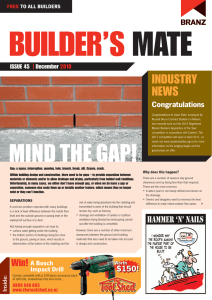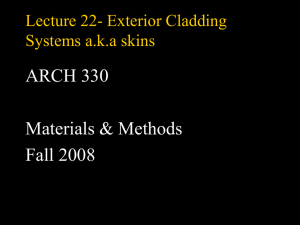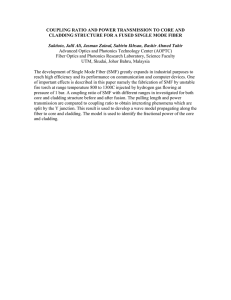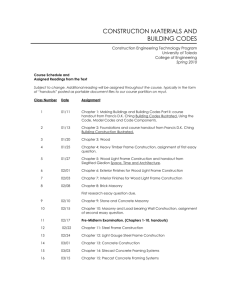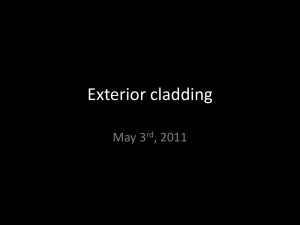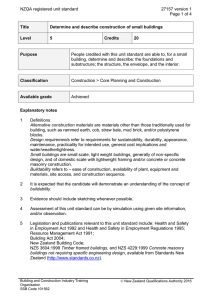Free PDF
advertisement
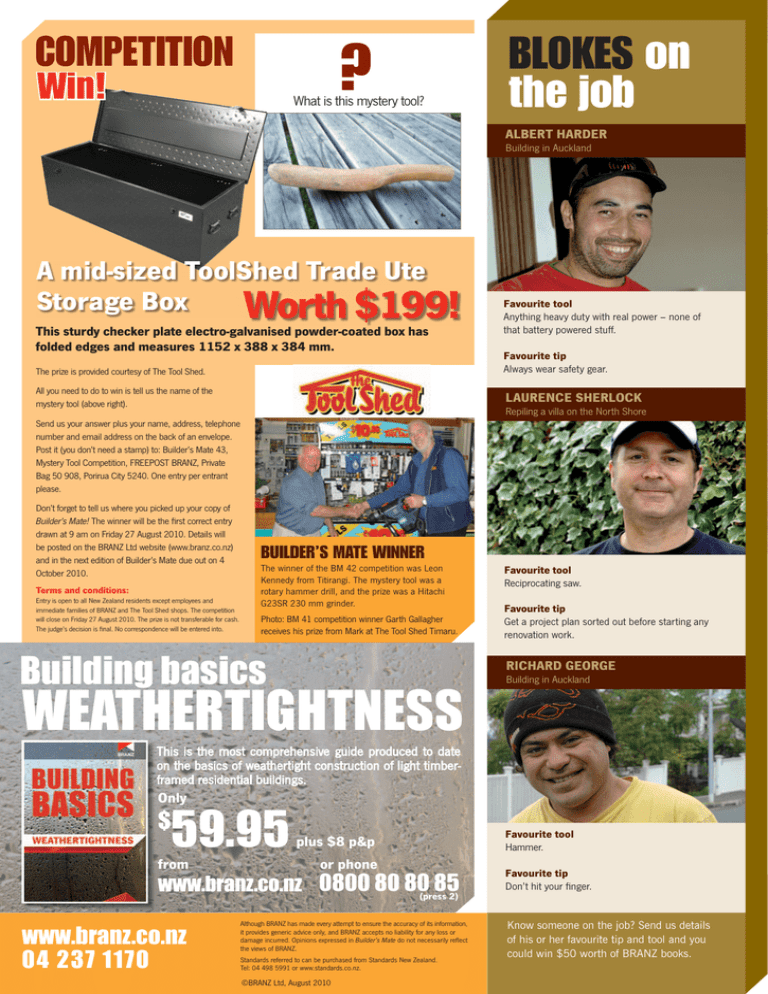
COMPETITION ? Win! What is this mystery tool? BLOKES on the job ALBERT HARDER Building in Auckland A mid-sized ToolShed Trade Ute Storage Box Worth $199! This sturdy checker plate electro-galvanised powder-coated box has folded edges and measures 1152 x 388 x 384 mm. Favourite tool Anything heavy duty with real power – none of that battery powered stuff. The prize is provided courtesy of The Tool Shed. Favourite tip Always wear safety gear. All you need to do to win is tell us the name of the mystery tool (above right). LAURENCE SHERLOCK Repiling a villa on the North Shore Send us your answer plus your name, address, telephone number and email address on the back of an envelope. Post it (you don’t need a stamp) to: Builder’s Mate 43, Mystery Tool Competition, FREEPOST BRANZ, Private Bag 50 908, Porirua City 5240. One entry per entrant please. Don’t forget to tell us where you picked up your copy of Builder’s Mate! The winner will be the first correct entry drawn at 9 am on Friday 27 August 2010. Details will be posted on the BRANZ Ltd website (www.branz.co.nz) and in the next edition of Builder’s Mate due out on 4 October 2010. Terms and conditions: Entry is open to all New Zealand residents except employees and immediate families of BRANZ and The Tool Shed shops. The competition will close on Friday 27 August 2010. The prize is not transferable for cash. The judge’s decision is final. No correspondence will be entered into. BUILDER’S MATE WINNER The winner of the BM 42 competition was Leon Kennedy from Titirangi. The mystery tool was a rotary hammer drill, and the prize was a Hitachi G23SR 230 mm grinder. Photo: BM 41 competition winner Garth Gallagher receives his prize from Mark at The Tool Shed Timaru. Building basics Favourite tool Reciprocating saw. Favourite tip Get a project plan sorted out before starting any renovation work. RICHARD GEORGE WEATHERTIGHTNESS Building in Auckland This is the most comprehensive guide produced to date on the basics of weathertight construction of light timberframed residential buildings. Only $ 59.95 from plus $8 p&p or phone 852) www.branz.co.nz 0800 80 80(press www.branz.co.nz 04 237 1170 Although BRANZ has made every attempt to ensure the accuracy of its information, it provides generic advice only, and BRANZ accepts no liability for any loss or damage incurred. Opinions expressed in Builder’s Mate do not necessarily reflect the views of BRANZ. Standards referred to can be purchased from Standards New Zealand. Tel: 04 498 5991 or www.standards.co.nz. ©BRANZ Ltd, August 2010 Favourite tool Hammer. Favourite tip Don’t hit your finger. Know someone on the job? Send us details of his or her favourite tip and tool and you could win $50 worth of BRANZ books. FREE TO ALL BUILDERS BUILDER’S MATE ISSUE 43 | August 2010 INDUSTRY NEWS BRANZ NEWS GROUND CLEARANCES The BRANZ Building basics series was launched in July with the publication of Weathertightness – written especially for builders. The book is packed with ‘must know’ information and clear 3D drawings that show how water can penetrate a building and how it can be designed and constructed using the 4Ds – deflection, drainage, drying and durability – to protect the building from damage. With all the rain we’ve had lately, it’s timely to remember that the term ‘indoor-outdoor flow’ should have nothing to do with water. Some owners and designers might desire ground and paving levels that are close to floor levels to avoid having steps between the inside and the outside of a building, but this can have a serious effect on material durability and occupant health. It’s vital for builders to observe ground clearances – the minimum distances that claddings and floor levels must be from the ground levels outside or under the building to keep the building materials and interior as dry as possible. What sort of problems can happen if ground clearances aren’t observed? •Water splash onto absorbent claddings. •Cladding, framing or flooring absorbing water. •Premature failure of paint finishes when claddings are continuously damp, for example, when soil is in contact with the cladding. •Blocked drainage from E2/AS1 20 mm cavities. •Blocked drainage slots for veneer cladding – water builds up in the cavity, causing rot, dampness and mould inside the building. •Blocked drainage slots for aluminium joinery – water drains inside, damaging floors and floor coverings. •Paving, paths and gardens that have been built up against the wall cladding, often with the finished ground levels (for example, paving) above floor levels, causing water to flow inside. •Blocked subfloor ventilation openings in suspended timber floors – dampness causes Inside: mid-sized ToolShed Win! ATrade Ute Storage Box NEWSFLASH: Big savings with the new ToolShed Trade product line – concrete breakers, chisels, levels, cutters, snips, clamps and more... 0800 948 665 – www.thetoolshed.co.nz Worth $199! premature deterioration of timber framing and flooring materials. •Suspended timber floors too close to the ground – moisture from the ground that gets absorbed by framing, flooring and cladding can cause rot, dampness and mould inside the building. > > Continued from previous page •Inadequate space for maintenance access under suspended timber floors. •Increased humidity levels inside the building. •Surface water entering the foul water drainage system because the gully trap is installed below ground level. How can problems be avoided? •Ask for accurate drawings from the designer and follow them. These should show correct site levels (including contours and slopes) and minimum slab to ground clearances. •Ensure the set-out on site works from the datum point that the designer has used. •Make allowance for future landscaping, particularly where extra soil will be brought on site or where paving will be added. •Remove surplus soil from the area immediately around the building. •Make sure drainage slots to veneer claddings and aluminium joinery are clear. •Don’t obstruct subfloor vents with framing, plaster or paint. •Ensure basement walls that are retaining soil are tanked to prevent moisture entry. •Advise the owner not to build up soil, mulch, paths, driveways or paving around the base of the building (unless the top surface will be below the bottom edge of the cladding (see table below), any subfloor vents or veneer drainage slots) and not to place any planting in front of subfloor vents. •Slope the area around the building away from it so that surface water does not drain towards the building. Minimum permitted ground clearances The rules for minimum clearances are set out in Building Code Acceptable Solution E1/AS1 and NZS 3604. Top of concrete slab-on-ground – veneer cladding – above paving 100 mm Top of concrete slab-on-ground – veneer cladding – above soil 150 mm Top of concrete slab-on-ground – other cladding – above paving 150 mm Top of concrete slab-on-ground – other cladding – above soil 225 mm Top of timber pile above finished ground level 300 mm or 150 mm with DPC Top of concrete pile above finished ground level 150 mm with DPC Top of foundation wall above finished ground level 225 mm Suspended timber floor construction – bottom of cladding 200 mm Suspended timber floor construction – underside of joists (i.e. crawlspace) 450 mm Bottom of cladding to paving – except masonry veneer 100 mm Bottom of cladding to unpaved ground – except masonry veneer 175 mm See Bulletin 353 Ground clearances for more information. Dribblings from the Old Geezer Recently, I have been thinking about anarchy and mental health. Anarchy is a state without government, and popular understanding portrays chaos. But is it always? Anarchists have a creed of ‘direct action’. If something needs to be done… just do it. Of course, this is the way our colonial forebears did things. The early whalers and miners built rudimentary shelters to fit their needs. Later, as settlers brought their wives and families, they built houses to much better standards. There was no one telling them to do this. It was pride, and it was all ‘direct action’ stuff. No rules, no intruding guidance. Similarly, the pa down the road already had a magnificent wharenui that had been built with the same idea. There wasn’t a code that said what the tahuhu (ridge beam) had to be made from and how big it had to be. Tane knew that already because Te Karu’s one had fallen down. Maori had no written language, yet could measure, calculate and construct to suit their needs perfectly. The trouble with making rules is that, once made, you need punishment for breaking those rules and a regime to administer the conforming and non-conforming. Our forebears would be astonished to see the level of governance now involved in building your own woodshed once it is more than 10 m2. Their way may have been anarchy, but are we really building any better? Mental health? I think the person who originally decided something that wasn’t broken needed fixing was possibly in need of help. Pride, more than rules, makes good construction. Des Molloy Do you get your free Build magazine? All building contractors who are in the business of building and have paid a Building Research Levy in the current year can receive BRANZ’s Build magazine for free. This Levy is paid as part of the building consent fee on all construction projects over $20,000. If you are missing out on your free copy of Build, call 0800 80 80 85 (press 2) or email verachan@branz.co.nz. BOTTOM PLATE FIXINGS TO SLABON-GROUND FLOORS There are two separate criteria for the fixing of bottom plates to slab-on-ground floors: At a glance CONCRETE SLAB-ONGROUND CLEARANCES Check the ground clearances when you’re working out the height of your foundation walls – and don’t build up gardens or lawns to reduce them. Masonry veneer with permanent paving masonry veneer cladding permanent paving 1.For fixing down timber plates as required by NZS 3604 7.5.12. 100 mm 2.As hold-down fixings for bottom plates for proprietary bracing systems. Bottom plates generally In the first criteria, where proprietary fasteners are used, these must be tested to provide minimum capacity loads. The fasteners must be within 150 mm of each end of the plate and at no more than 900 mm centres. It is still possible to use proprietary fasteners that have been tested and shown to have lower capacities by closing up the fastener centres. Proprietary bracing systems Fasteners for proprietary systems are for holding down both ends of bracing elements. The need here is for a much higher tensile strength, which is specified by the bracing system manufacturer. Bottom plate fixings for internal walls Proprietary fasteners require a minimum concrete slab thickness. Most fastener suppliers require the hole to be drilled 10 mm deeper than the fastener embedment length. BRANZ recommend an additional 10 mm min of concrete below the hole. This means that a fastener with up to 80 mm embedment length can be used in a standard 100 mm slab-on-ground, provided there is a DPM under the slab. Where fasteners have a greater embedment length, there must be a slab thickening. Drill depth guide stops must be used when drilling holes in slabs to prevent overdrilling causing breaking out of the underside of the slab and rupturing of the membrane. Masonry veneer with unpaved ground masonry veneer cladding Considerations at the design and consenting stage, and before use: 1.What is the rating of the fixing proposed? Does it have the required rating for (a) the bottom plates (See NZS 3604:1999 section 7 Cl 7.5.12) or (b) the proposed proprietary bracing system? unpaved ground 150 mm Non-masonry cladding with permanent paving 2.What depth of concrete does the fastener require? 3.Can the edge distance requirement for the fastener be achieved? 4.Does it meet the durability requirement? In concrete, 50 mm cover is required in all zones. Permanent concrete masonry formwork requires cover of 60 mm in the sea spray zone, this may not be achievable with 90mm framing. Both concrete and masonry foundations require a minimum of 25 MPa concrete in the sea spray zone. Lesser cover may be allowable in other zones but these lesser covers could be overridden by the structural edge distance requirements for proprietary fasteners. 5.Make sure the drill bit used is in good condition and will drill the correct diameter hole. Worn drill bits will cause the fastener to bind in the hole, particularly with screw anchors. non-masonry cladding permanent paving 150 mm Non-masonry cladding with unpaved ground non-masonry cladding unpaved ground 225 mm
